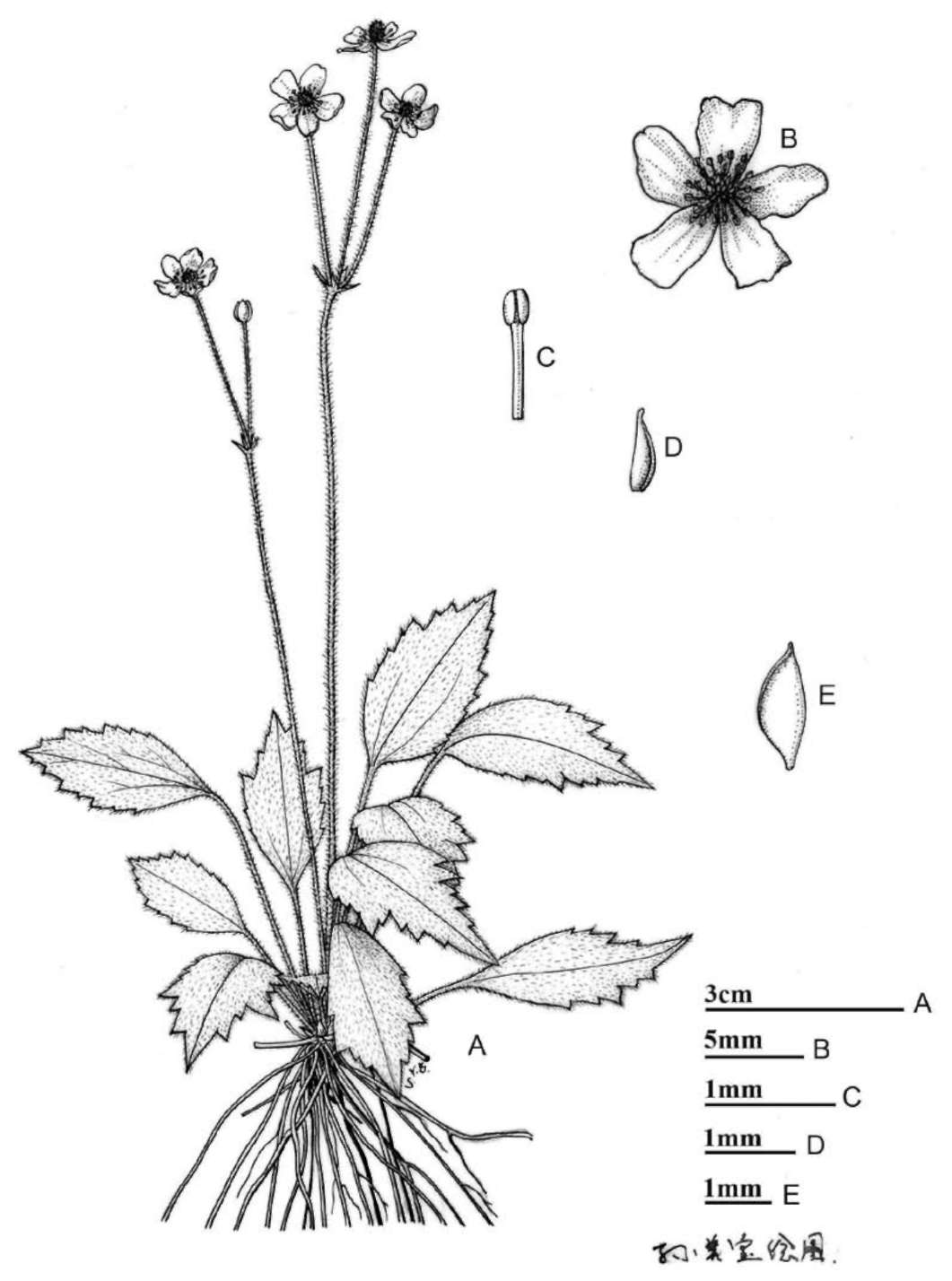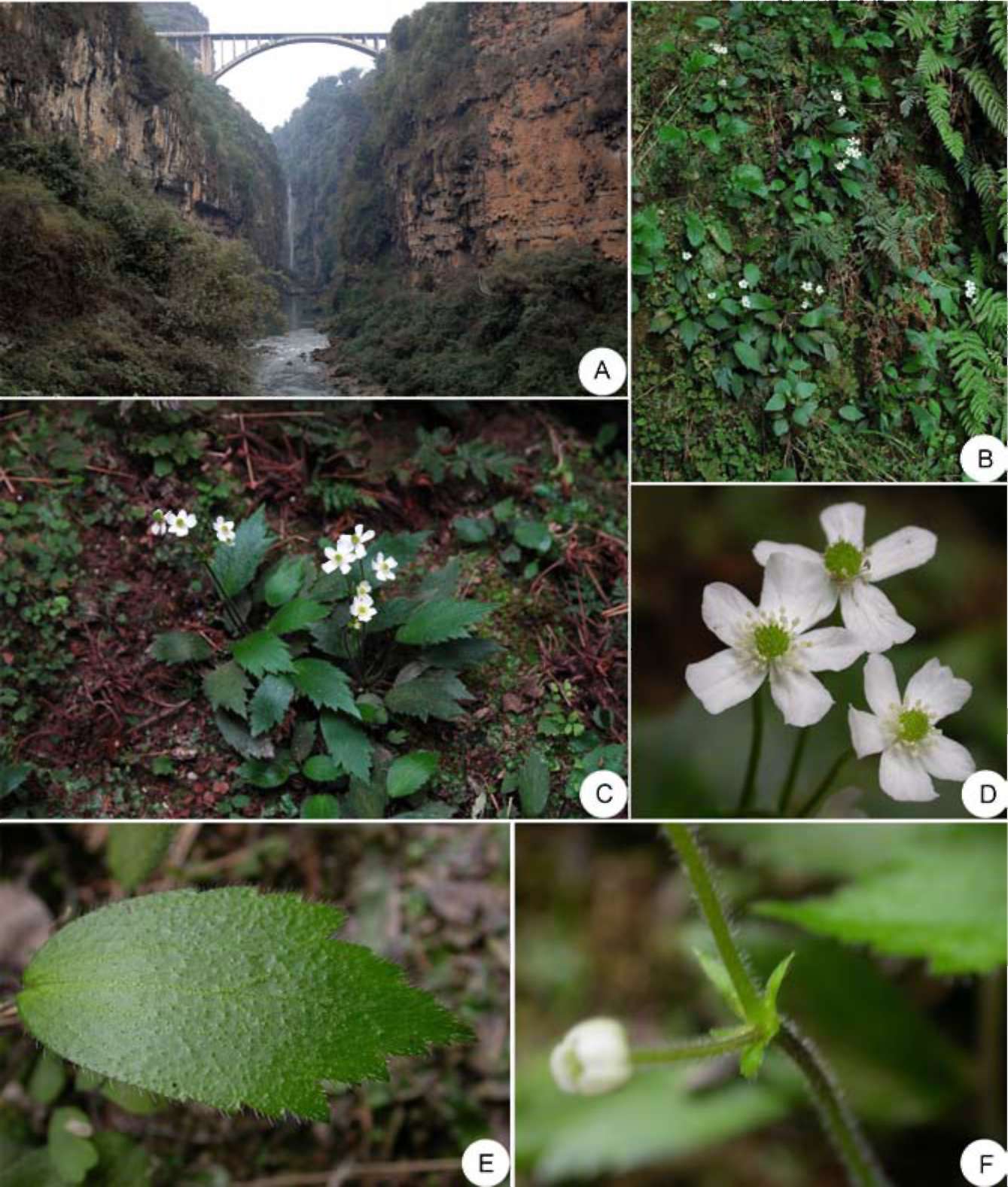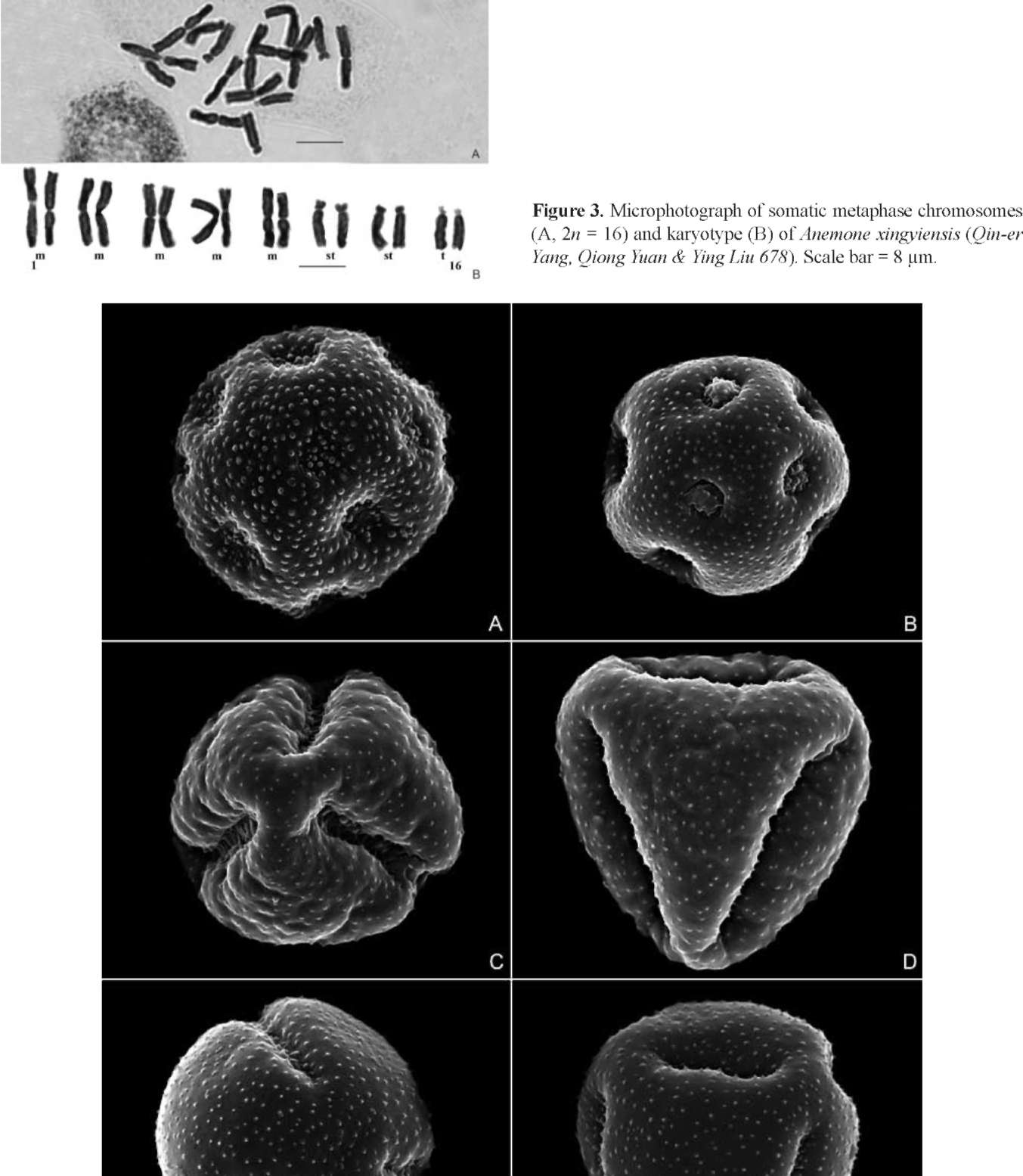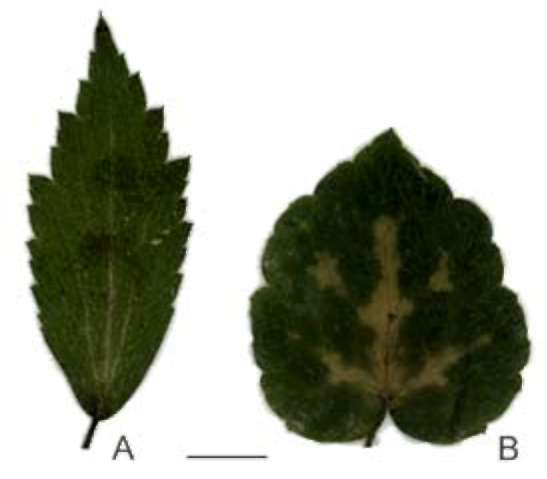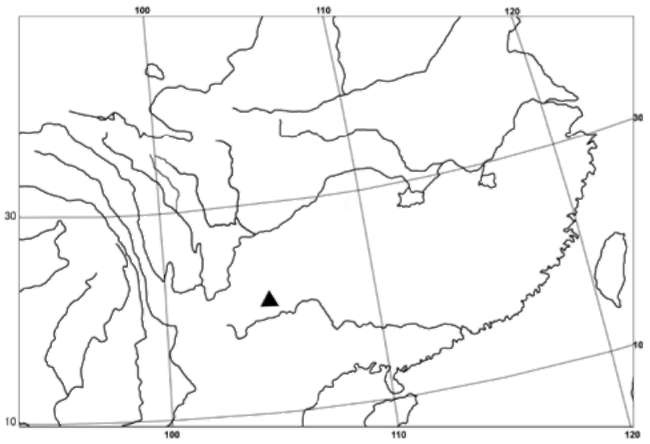|
|
|
|
|
|
|
|
|
|
|
|
|
Botanical Studies (2009) 50: 493-498.
|
|
|
|
|
|
|
|
|
|
|
|
|
|
Anemone xingyiensis (Ranunculaceae), a new species from Guizhou, China
Qiong YUAN and Qin-Er YANG*
Key Laboratory of Plant Resources Conservation and Sustainable Utilization, South China Botanical Garden, Chinese Academy of Sciences, Xingke Road 723, Tianhe District, Guangzhou 510650, China
(Received June 5, 2008; Accepted March 16, 2009)
ABSTRACT. Anemone xingyiensis (Ranunculaceae), a new species from Guizhou Province, China, is described and illustrated. Anemone xingyiensis has undivided or indistinctly trilobate leaves, three or four small, sessile involucral leaves, five white sepals, filiform filaments, and glabrous achenes short-beaked and longitudinally 1-ribbed, and thus belongs to section Begoniifolia (Ulbr.) Tamura. It is closely related to A. begoniifolia H. Lev. & Vaniot, but differs by having elliptic or narrowly flabellate leaves, which are obviously cuneate at the base and have irregularly serrate margins. The pollen morphology also suggests the close affinity of the two species. The chromosome count for A. xingyiensis is 2n = 16, and the karyotype formula is 2n =10m + 4st + 2t. A color plate, line drawings, distribution map, and SEM microphotographs of the pollen are provided.
Keywords: Anemone xingyiensis; Chromosome cytology; New species; Pollen morphology; Ranunculaceae; Taxonomy.
|
|
|
|
|
|
|
|
INTRODUCTION
On a botanical trip in April 2007 to Guizhou Province, south central China, we collected a fruiting plant of Anemone in the Malinghe Valley in Xingyi City. The plant had undivided or indistinctly trilobate leaves, three or four small, sessile involucral leaves, and glabrous, short-beaked, and longitudinally 1-ribbed achenes. It thus obviously belongs to the small section Begoniifolia (Ulbr.) Tamura, in which only five species were previously known (Tamura, 1995). The leaves of the plant, which are elliptic or narrowly flabellate in outline and obviously cuneate at the base and have irregularly serrate margins, are unique in the section. In March 2008, we returned to Xingyi and successfully collected flowering specimens. Upon careful comparison with all species heretofore known in section Begoniifolia, we determined that the plant is indeed distinguishable within the section by its leaf shape and thus represents an undescribed species.
NEW SPECIES
Anemone xingyiensis Q. Yuan & Q. E. Yang, sp. nov. -TYPE: CHINA. Guizhou, Xingyi City, Malinghe Valley, 1,000 m alt. , moist places on karst cliff,
25 March 2007, Qiong Yuan & Qin-er Yang 1077
(holotype: IBSC).興義銀蓮花 Figures 1, 2
|
Haec species affinis A. begoniifoliae H. Lev. & Vaniot, a qua foliis ellipticis vel anguste flabellatis basi cuneatis margine irregulariter serratis differt.
Herbs to 16 cm tall. Rhizome ascending, short, 7-8 mm in diam. Leaves 9-20; petiole 4-8 cm long, sparsely puber-ulent, base sheathing; leaf blade undivided or indistinctly 3-lobed, elliptic or narrowly flabellate, 3-6 cm long, 1-2.5 cm wide, more or less densely villous, base cuneate, margin irregularly serrate, apex acute or acuminate. Scapes 1-3, 6-16 cm long, villous; cyme 1-5-flowered. Involucral bracts 3 or 4, sessile; bract blade 3-lobed or undivided, oblong, 3-5 mm long, densely puberulent, apex acute. Pedicel 2-3 cm long, densely puberulent. Sepals 5, white, obovate, apex rounded or truncate, sometimes emarginate, ca. 5 mm long, ca. 3 mm wide, abaxially sparsely puberu-lent. Stamens ca. 2 mm long; filament filiform; anthers ellipsoid or cylindrical, ca. 1 mm long, apex rounded. Pistils ovoid, subglabrous. Achene body curved, rhombic-obovoid, ca. 1 mm long, ca. 0.5 mm wide, longitudinally 1-ribbed; style curved, ca. 0.5 mm long.
Additional specimen examined. CHINA. Guizhou, Xingyi City, Malinghe Valley, 1,000 m alt., moist places on karst cliff, 21 Apr 2007, Qin-er Yang, Qiong Yuan & Ying Liu 678 (IBSC).
Etymology. The specific epithet 'xingyiensis' is derived from the type locality, Xingyi City, Guizhou, China.
Phenology. Flowering March; fruiting April.
Chromosome cytology. For cytological observations, actively growing root tips were pretreated in 0.1% colchi-
|
|
|
|
*Corresponding authors: E-mail: qeyang@scib.ac.cn; Tel: +86-20-37094273; Fax: +86-20-37094273.
|
|
|
|
|
|
|
|
|
|
|
|
|
|
|
|
|
|
|
|
|
|
|
|
|
Botanical Studies, Vol. 50, 2009
|
|
|
|
|
|
|
|
cine at about 20°C for 3 h, fixed in Carnoy I (glacial acetic acid: absolute ethanol = 1:3) at 4°C for 30 min, macerated in a 1:1 mixture of 1M HCl and 45% acetic acid at 60°C for 2 min, and then stained and squashed in 1% aceto-orcein.
The karyotype formula is based on measurements of mitotic-metaphase chromosomes taken from photographs. The symbols used to describe the karyotype follow Levan et al. (1964): m = median centromeric chromosome with arm ratio of 1-1.7; st = subterminal centromeric chromo-
|
some with arm ratio of 3-7; t = terminal centromeric chromosome with arm ratio of 7-co.
The chromosomes of Anemone xingyiensis were determined to be 2n = 16 (Figure 3A), 10 of which were median-centromeric, four subterminal-centromeric and two terminal-centromeric. The karyotype was formulated as 2n = 1 0m + 4st + 2t (Figure 3B). Two additional species for which chromosome data are available within section Begoniifoliae, A. begoniifolia and A. orthocarpa Hand.-Mazz., have the same chromosome number and
|
|
|
|
|
|
|
|
|
|
|
|
|
|
|
|
Figure 1. Anemone xingyiensis. A, Habit; B, Flower; C, Stamen; D, Carpel; E, Achene. (A, B, C and D from Qiong Yuan & Qin-er Yang 1077; E from Qin-er Yang, Qiong Yuan & Ying Liu 678).
|
|
|
|
|
|
|
|
|
|
|
|
|
|
|
|
|
|
|
|
|
|
|
YUAN and YANG ― Anemone xingyiensis, a new species from China
|
|
|
|
|
|
|
|
|
morphology (Yang, 2002, and unpublished). The basic chromosome number of section Begoniifolia should be x = 8.
Pollen morphology. For scanning electron microscopy (SEM) observation of the pollen morphology, pollen
|
samples were collected from herbarium specimens. Pollen grains were mounted directly on double-sided adhesive tape, coated with gold for 3 min, and then examined and photographed using a Hitachi S-800 scanning electron microscope.
|
|
|
|
|
|
|
|
|
|
|
|
|
|
|
|
Figure 2. Anemone xingyiensis. A, Habitat: limestone cliffs (Malinghe Valley, Xingyi); B, Habitat; C, Habit; D, Flowers; E, Leaf; F, Involucral leaves. (From Qiong Yuan & Qin-er Yang 1077)
|
|
|
|
|
|
|
|
|
|
|
|
|
|
|
|
|
|
|
|
|
|
|
|
Botanical Studies, Vol. 50, 2009
|
|
|
|
|
|
|
|
|
|
|
|
|
|
|
|
Figure 4. SEM photographs of pollen in four species of Anemone. A, A. xingyiensis (Qiong Yuan & Qin-er Yang 1077); B, A. begoniifolia (Qin-er Yang & Min Feng 95-12, collected from Jinfoshan, Nanchuan, Chongqing, kept in PE); C, D, A. orthocarpa (Qiong Yuan & Qin-er Yang 1080, collected from Xingyi, Guizhou, kept in IBSC); E, F, A. howellii (Yin-zheng Wang 4177, collected from Malipo, Yunnan, kept in PE). Scale bar = 10 (im.
|
|
|
|
|
|
|
|
|
|
|
|
|
|
|
|
|
|
|
|
|
|
YUAN and YANG ― Anemone xingyiensis, a new species from China 497
|
|
|
|
|
|
|
|
Pollen grains of Anemone xingyiensis are globose with punctate tectum and are pantoporate (Figure 4A). The pollen morphology of Anemone xingyiensis is similar to that of A. begoniifolia (Figure 4B), but obviously different from that of A. orthocarpa (Figure 4C, D) and A. howellii Jeffrey & W. Smith (Figure 4E, F), both of which have 6-pantocolpate pollen grains. The pollen grains of A. howellii have been described as 3-colpate (Wang, 1980), but that report was not confirmed in the present study. The pollen morphology strongly suggests a close relationship between A. xingyiensis and A. begoniifolia.
Ecology, distribution and status. Anemone xingyiensis is known only from the type locality in the Malinghe Valley, Xingyi City, Guizhou Province, China (Figure 5). It grows in moist places on karst cliffs. The population we discovered is small, including approximately 80 individuals. According to the IUCN red list categories and criteria, Version 3.1 (IUCN, 2001), Anemone xingyiensis should be categorized as critically endangered (CR). The Malinghe Valley, which is 74.8 km long, 50-150 m wide, and 120-280 m deep, and originally difficult to access, is now established as a national geological park open to tourists, which may seriously affect the survival of A. xingyiensis, since it grows along trailsides and has attractive showy white flowers.
Notes. Anemone xingyiensis is closely related to A. begoniifolia, differing by the elliptic or narrowly flabellate leaves that are obviously cuneate at the base and usually have irregularly serrate margins (Figure 6A). In A. begoni-ifolia, the leaves are broadly ovate or cordate-ovate, often deeply cordate at the base and have more or less regularly crenate-mucronulate margins (Figure 6B).
Prior to the discovery of Anemone xingyiensis, section Begoniifolia included only five species: A. begoniifolia, A. howellii, A. hokouensis C. Y. Wu ex W. T. Wang, A. orthocarpa, and A. sumatrana de Vries (Tamura, 1995). Among them, A. begoniifolia, A. hokouensis, and A. orthocarpa are endemic to China. Anemone howellii is distributed in western China, northern Myanmar, and in Assam, India. Anemone hokouensis, a species very similar to A. howellii, is represented only by the type, and thus
|
|
|
|
|
Figure 6. Comparison of leaf morphology of Anemone xingyiensis (A) and A. begoniifolia (B). (A from Qin-er Yang, Qiong Yuan & Ying Liu 678; B from Qin-er Yang, Qiong Yuan & Ying Liu 731, collected at Jinfoshan, Nanchuan, Chongqing, kept
in IBSC). Scale bar = 1 cm.
field work should be undertaken to determine its identity. Anemone orthocarpa is locally endemic to Xingyi. Anemone sumatrana, the sole species of the section not occurring in China, has its distribution on the Malay Peninsula and in Sumatra (Eichler, 1958; Tamura, 1995). Anemone sumatrana and A. orthocarpa are different from the remaining species in the section by having 3-partite or 3-sect leaves; the other four species have undivided or 3 or 5-lobed leaves.
It is phytogeographically interesting that four of the six species recognized in Anemone section Begoniifolia occur in western Guizhou (Wang, 1980; this study), an area dominated by karst topography. All four species prefer shallow humid soils on limestone rocks. Western Guizhou is undoubtedly a differentiation center for the section. It is noteworthy that both A. orthocarpa and A. xingyiensis occur in the Malinghe Valley although they grow in somewhat different habitats. Anemone orthocarpa usually grows on relatively dry rocks under shrubs of Distylium (Hamamelidaceae) while A. xingyiensis usually grows on moist rocks in open places. Since the two species are so well differentiated in gross and pollen morphology, and have different habitat preferences, it is understandable that no intermediates have been found in the valley.
Xingyi, previously better known as Hoang-tsao-pa (Huang-cao-ba), is an area botanized very early by western
collectors. As early as 1909, and from 1913 to 1919, H.
J. Esquirol and P. J. Cavalerie, two French missionary collectors, collected botanical specimens in the area (W. T. Wang, unpublished). The discovery of Anemone xingyiensis indicates that our knowledge on the flora of the limestone areas in Guizhou is far from complete.
Acknowledgements. We thank Mr. Ying-bao Sun for the drawing and Ms. Ying Liu for help with the field work. This study was supported by a grant from the Na-
|
|
|
|
|
|
|
|
Figure 5. Distribution of Anemone xingyiensis.
|
|
|
|
|
|
|
|
|
|
|
|
|
|
|
|
|
|
|
|
|
|
|
Botanical Studies, Vol. 50, 2009
|
|
|
|
|
|
|
|
tional Natural Science Foundation of China (Grant No.
30570118).
LITERATURE CITED
Eichler, H. 1958. Revision der Ranunculaceen Malesiens.
Biblioth. Bot. 124: 1-110. (in German)
IUCN. 2001. IUCN Red List Categories and Criteria, version 3.1. IUCN Species Survival Commission, Gland/Cambridge.
Levan, A., K. Fredga, and A.A. Sandberg. 1964. Nomenclature for centromeric position on chromosomes. Hereditas 52:
|
201-220.
Tamura, M. 1 995. Ranunculaceae. In P. Hiepko (ed), Die Naturlichen Pflanzenfamilien, zweite Auflage, Band 17a IV.
Duncker & Humblot, Berlin, pp. 223-496.
Wang, W.T. 1980. Anemone L. In Anonymous (ed.). Flora Rei-publicae Popularis Sinicae, Vol. 27. Science Press, Beijing, pp. 1-56. (in Chinese)
Yang, Q.E. 2002. Cytology of ten species in Anemone, one in Anemoclema and six in Clematis (Trib. Anemoneae, Ranunculaceae) from China. Acta Phytotax. Sin. 40:
396-405.
|
|
|
|
|
|
|
|
中國貴州毛茛科銀蓮花屬一新種:興義銀蓮花
袁 瓊 楊親二
中國科學院植物資源保護與可持續利用重點實驗室(華南植物園)
本文描述了中國貴州產毛茛科銀蓮花屬一新種,即興義銀蓮花(Anemone xingyiensis)。該種葉不分
裂或不明顯三淺裂,總苞片3或4 ,頗小,無柄,花萼片5 ,白色,花絲絲形,瘦果無毛,具短喙和一
縱肋'故顯然屬於卵葉銀蓮花組(section Begoniifolia)。該種與卵葉銀蓮花最為近緣,但葉橢圓形或狹扇
形,基部楔形,邊緣具不規則鋸齒而與後者易於區別。花!粉形態也表明兩種植物頗為近緣。興義銀蓮花
的染色體數目為2n = 16 '核型公式為2n =10m + 4st + 2t 。本文提供了興義銀蓮花的野外照片、線繪圖、
花粉掃描電鏡照片和植物地理分佈圖。
關鍵詞:興義銀蓮花;染色體細胞學;新種;花粉形態;毛茛科;分類學。
|
|
|
|
|
|
|
|
|
|
|
